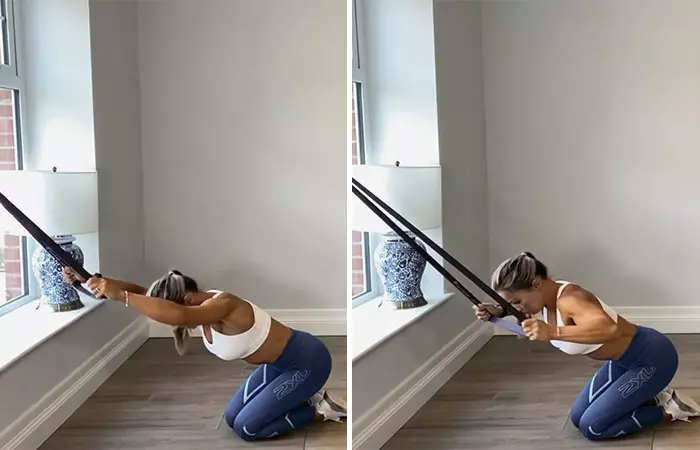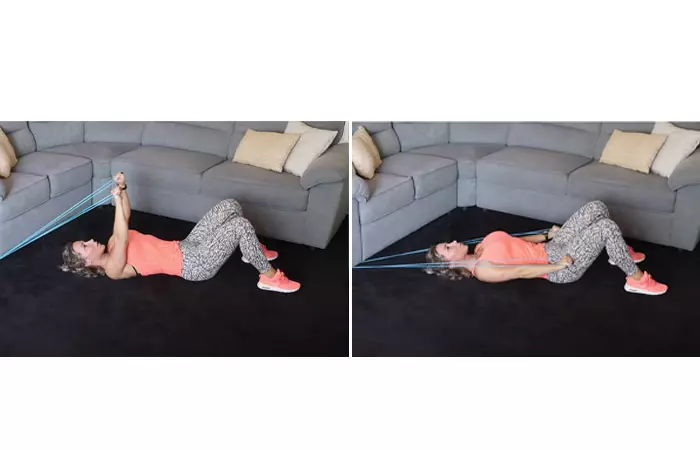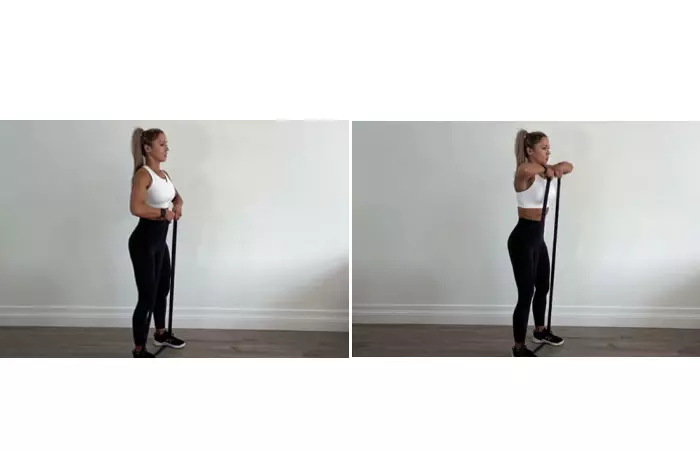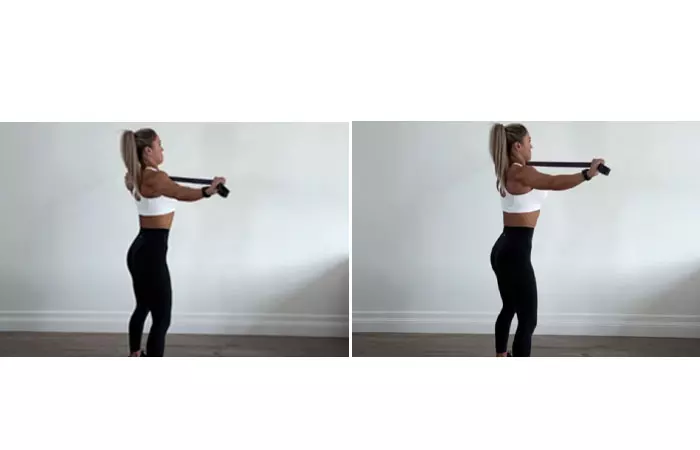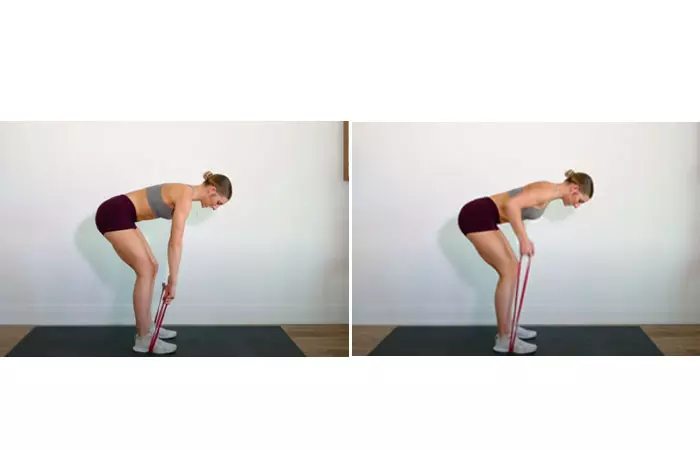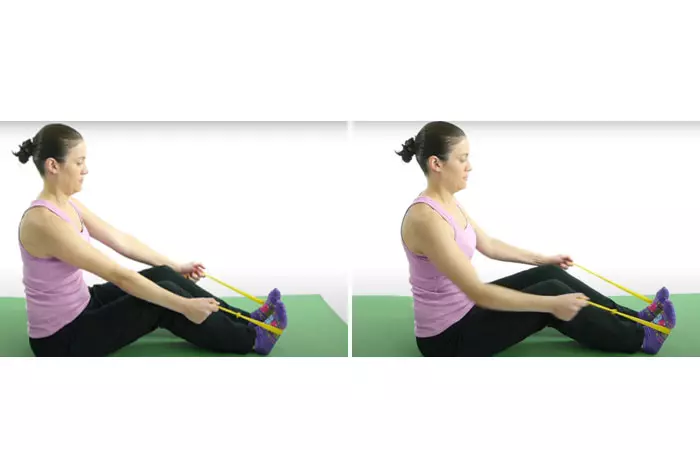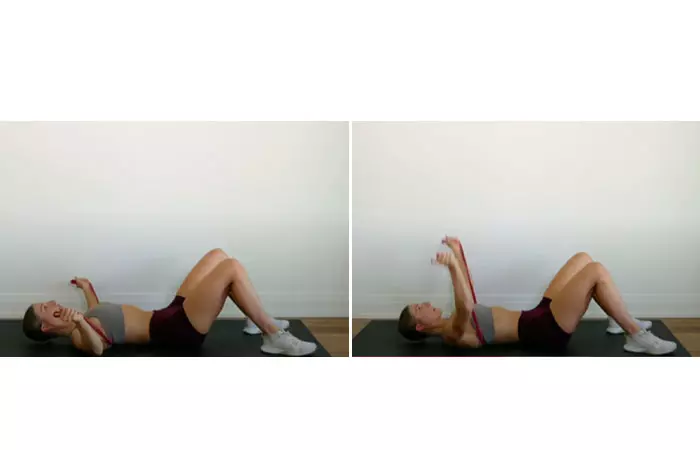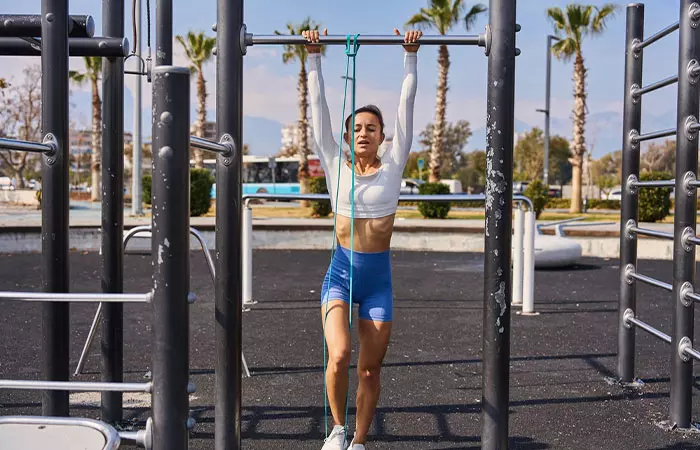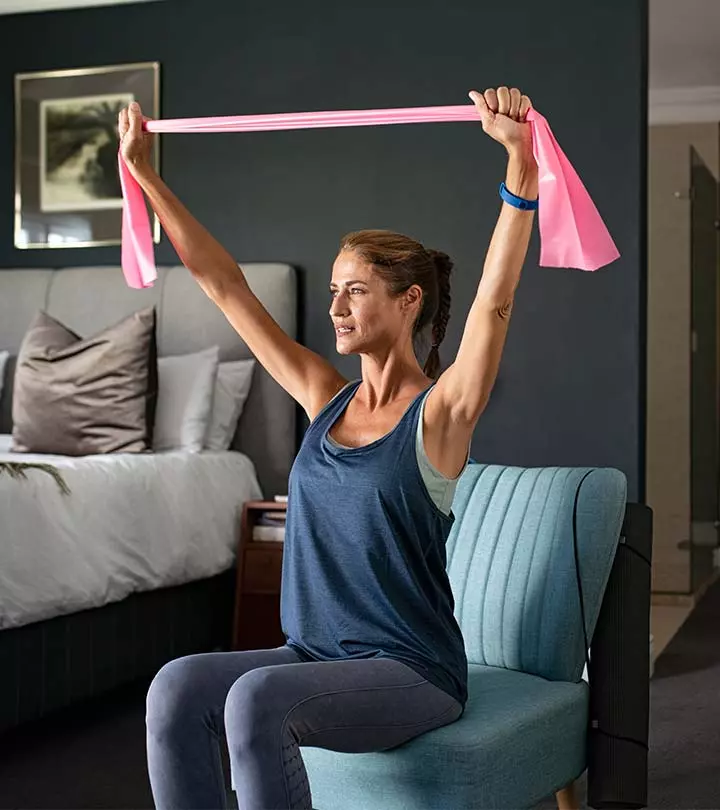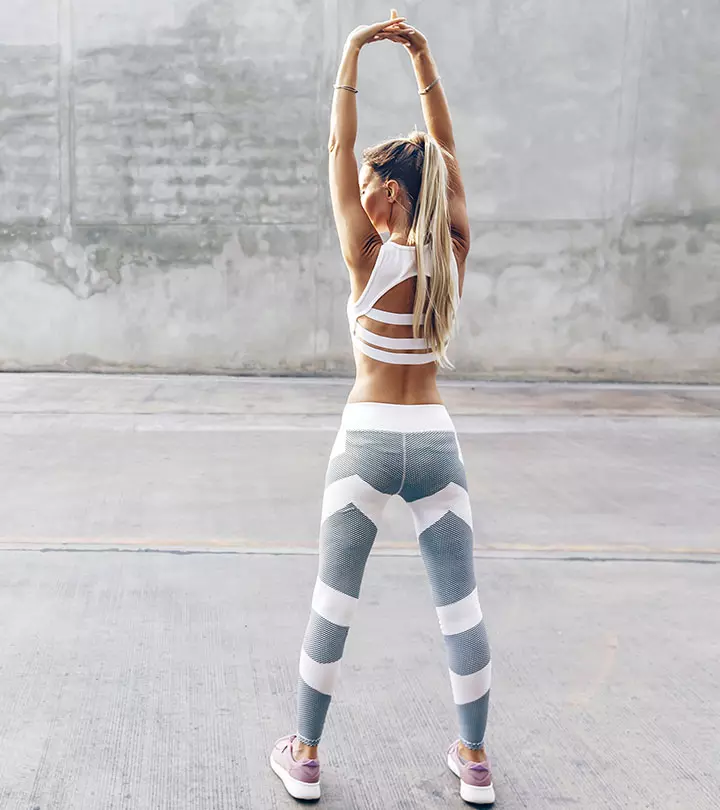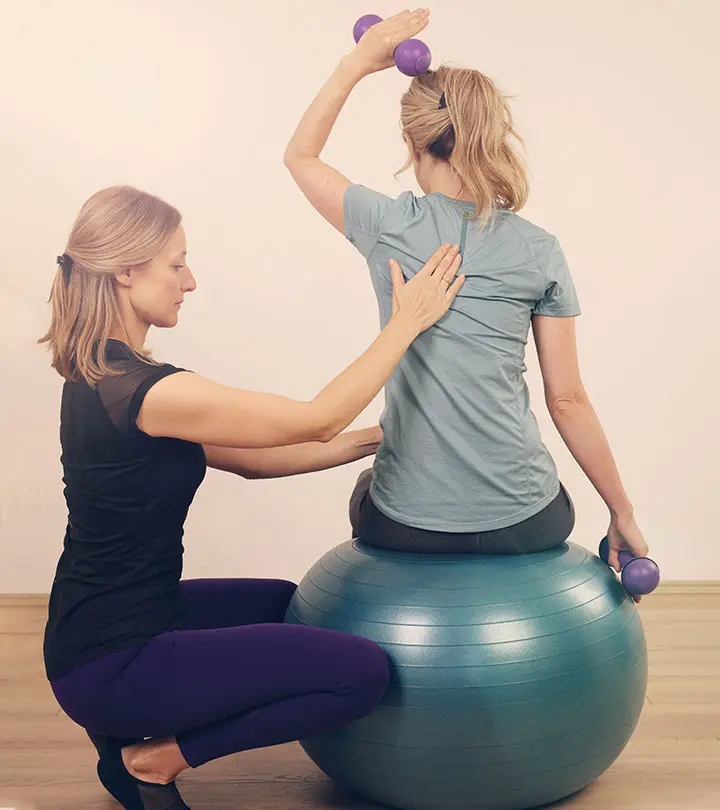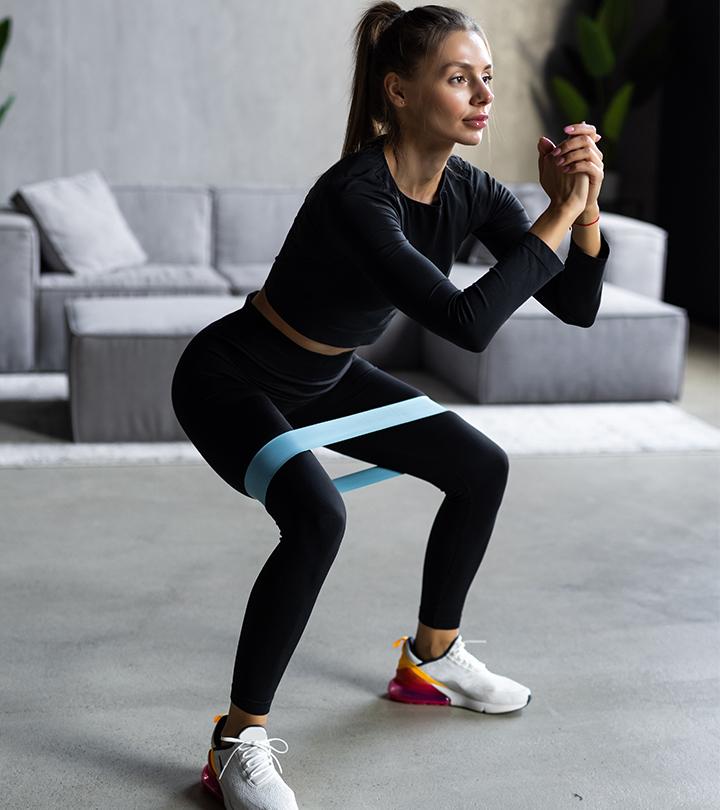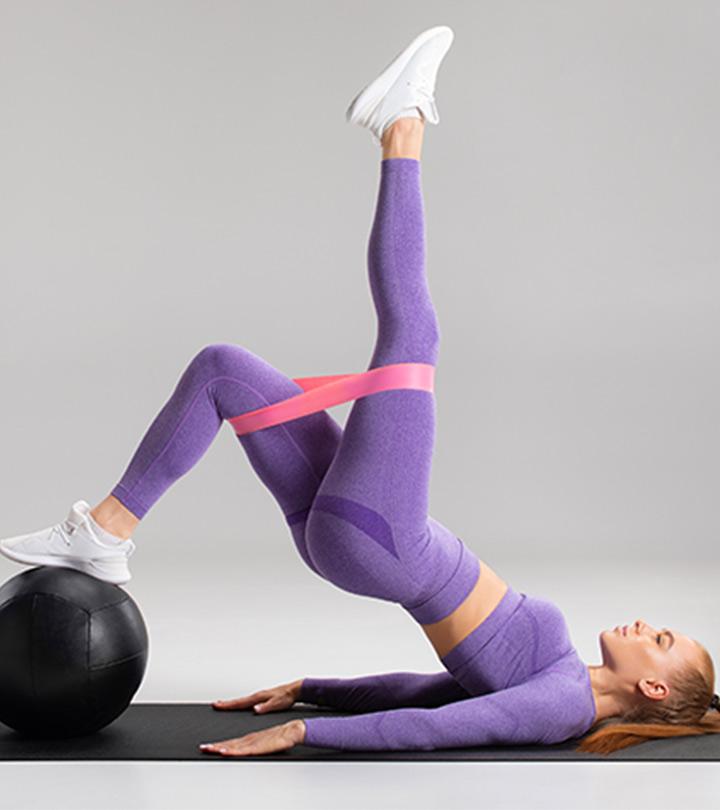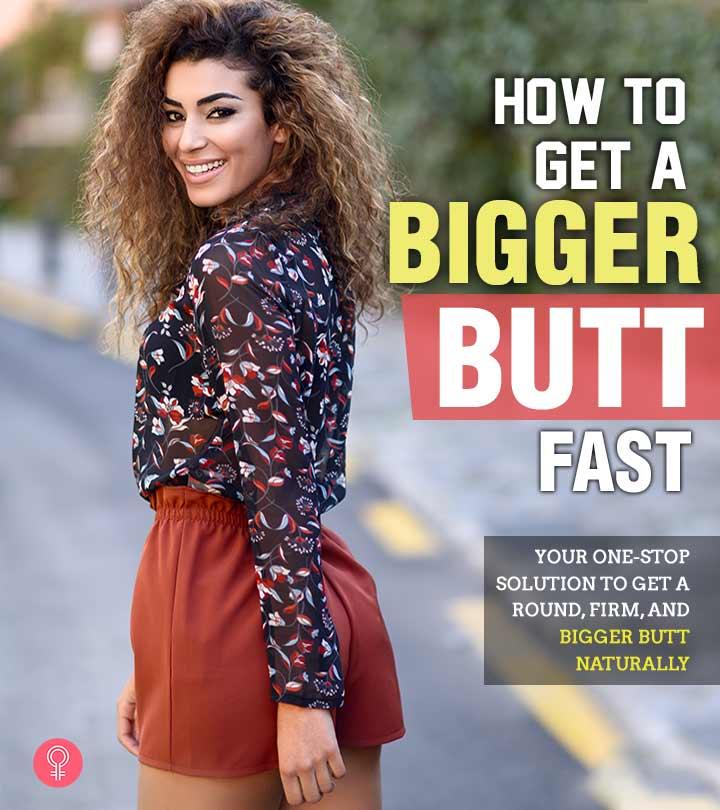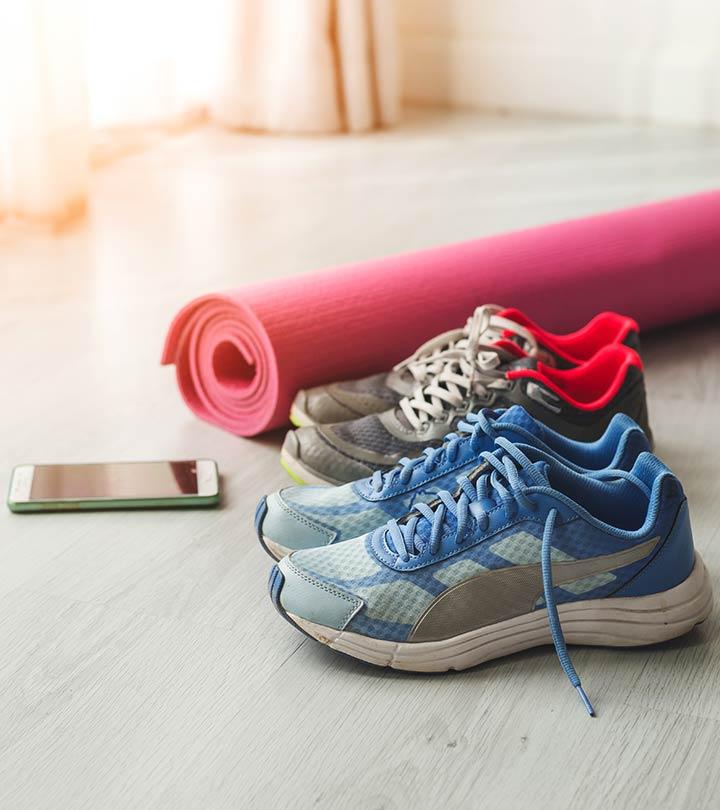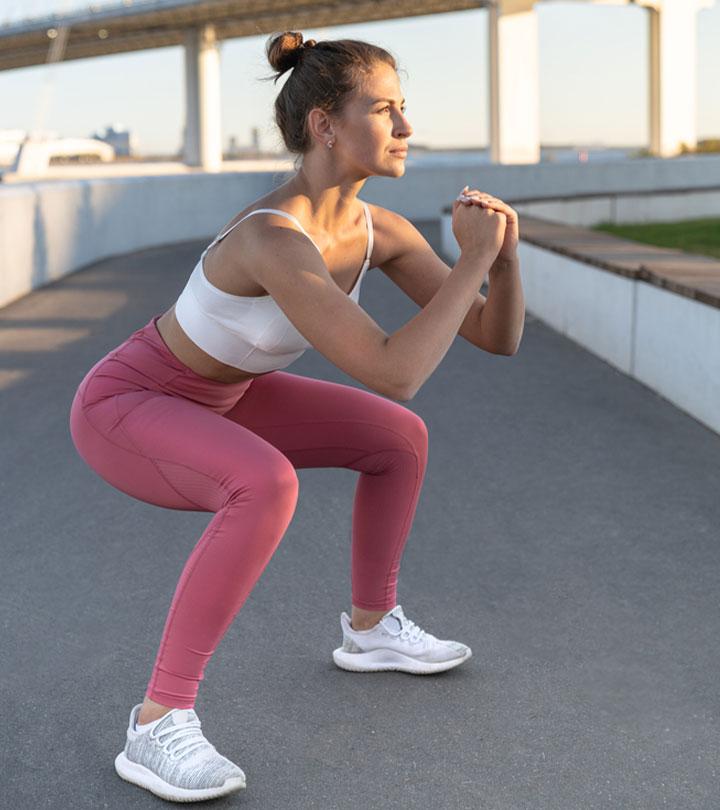12 Back Exercises With Resistance Bands To Reduce Pain And Improve Posture
Enjoy a pain-free workout with back-toning exercises like lateral raises and more.
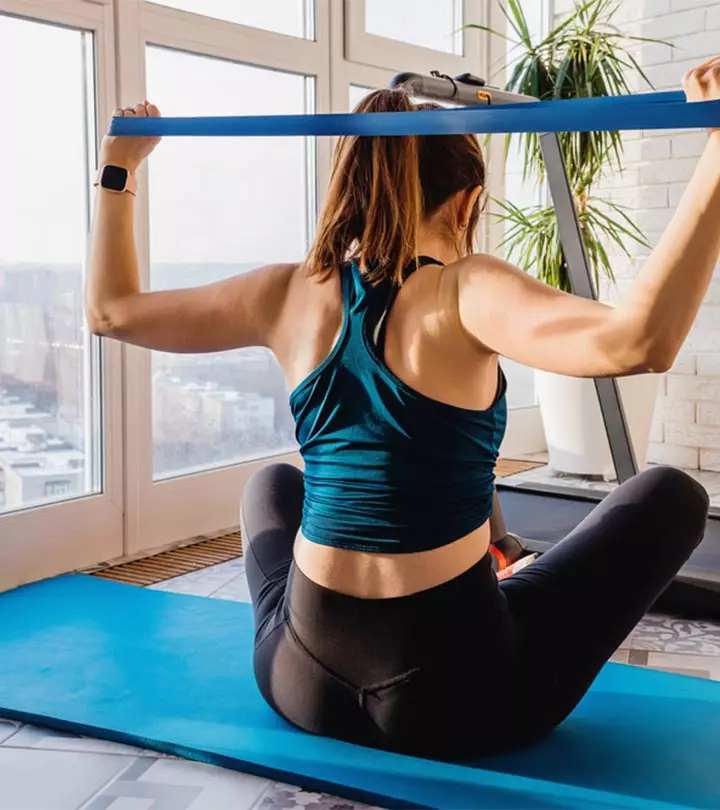
Image: Shutterstock
If you want a strong and toned back, do resistance band exercises for the back. They also help reduce pain and correct poor posture. Pete Colagiuri, a sports physiotherapist with over 20 years of experience, says, “Resistance bands are a great tool for rehabilitation of back pain.” He adds, “The elastic nature of the band is perfect for strength training as well.” Dr. Alex Tauberg (DC, CSCS, CCSP®, EMR) says, “Resistance bands are a great piece of home gym equipment. You can get resistance bands of all different intensity levels. They are inexpensive, portable, easy to store, and you can modify almost any exercise to use a resistance band.”
Resistance band exercises target and strengthen muscles like the abs, obliques, and glutes. This, in turn, helps in stabilizing the pelvic and lower back region. If you are working long hours sitting in front of a computer or lead a sedentary lifestyle and/or experience back pain – do resistance band exercises. Here are the 12 best at-home resistance band exercises for the back with pictures. Scroll down!
 Workout Blueprint: Resistance Band Exercises For The Back
Workout Blueprint: Resistance Band Exercises For The Back- Frequency: 2-3 times per week
- Benefits: Strengthen back muscles, improve posture, reduce pain, and enhance muscle tone
- Equipment Needed: Resistance bands
- Space Required: Small area
- Assistance Required: No
- Who Should Avoid: Individuals who have recently undergone back surgeries or have severe back injuries
In This Article
12 Best Resistance Band Exercises For The Back
1. Single Arm Press
Single arm press with resistance bands works on the lats and shoulders. This upper body exercise helps reduce neck pain, shoulder, and back pain and relieves muscle tension. Here’s how to do it:
Steps
- Take a loop resistance band. Hold it with your hands. Place your left hand on your right shoulder and keep the right hand free for movement. This is the starting position.
- Now, stretch the band in an out-and-up motion and bring it down the same way back to the starting position.
- Do 10 reps on each side.
 Quick Tip
Quick Tip2. Lat Pulldowns
Steps
- Secure an open-ended resistance band on a doorknob or pull-up bar. Hold the ends of the resistance band and kneel down. Keep your arms extended and your head at the same level as your arms while looking at the floor. This is the starting position.
- Now, pull the resistance band, bring your elbows back, and squeeze your shoulders.
- Go back to the starting position.
- Do 2 sets of 10 reps each.
3. One Arm Lateral Raise
One arm lateral raises work on the lats and shoulders. They help reduce muscle tension, improve shoulder and upper back posture, and improve muscle strength. Here’s how to do it:
Steps
- Take a loop resistance band. Hold it with your hands. Place your left hand on your right thigh and keep the right hand free for movement. This is the starting position.
- Now, pull your right hand up with your elbows and away from your body.
- Pause for a moment and bring the right arm back to the starting position.
- Do 10 reps on each side.
4. Lat Pullovers
Lat pullovers with a resistance band are a great workout for the lat muscles and the whole back. They help reduce shoulder muscle tension and pain. Here’s how to do it:
Steps
- Secure your resistance band under a sofa or a bench.
- Lie down on your back with your knees bent and feet flat on the floor. Hold the resistance band with your arms shoulder-width apart and extended slightly above the floor. This is the starting position.
- Now, pull the resistance band toward your pelvic region.
- Bring them back to the starting position.
- Do 2 sets of 10 reps each.
5. Shoulder Press
Steps
- Place a loop resistance band under your feet. Keep your feet shoulder-width apart to secure it. Keep your knees bent. Hold the resistance band with your hands and bring them up to your chest, palms facing upward. This is the starting position.
- Now, extend your arms up and bring them down to the starting position.
- Do 2 sets of 8-10 reps each.
6. Upright Row
Upright rows with resistance band work on the upper and middle back as well as the shoulders. It helps strengthen the shoulder and upper back. Here’s how to do it:
Steps
- Take a loop resistance band, place your feet on it shoulder-width apart to secure it. Keep your knees bent. Hold the resistance band with your hands close together. This is the starting position.
- Pull the resistance band up to your chest, with your elbows sticking out.
- Slowly lower your hands back to the starting position.
- Do 2 sets of 8-10 reps each.
7. Rear Deltoid Squeeze
This exercise works on the back of the shoulders and helps open up a rounded or hunched back. Here’s how to do it:
Steps
- Hold the resistance band with your arms wider than shoulder-width apart. Keep your legs shoulder-width apart and knees slightly bent. This is the starting position.
- Now, stretch the resistance band and pull your arms back slightly.
- Go back to the starting position.
- Do 2 sets of 8 reps each.
8. Bent Over Rows
Resistance band bent over rows target the middle back or lats, as well as the biceps. Here’s how to do it:
Steps
- Take a loop resistance band. Hold it at shoulder-width. Step on the band to secure it. Keep your feet shoulder-width apart and knees bent. Bend forward from the pelvis, keeping your hands extended. This is the starting position.
- Now, pull the resistance band up. Let your elbows stick out to the back and squeeze your shoulder blades.
- Slowly extend your hands back to the starting position.
- Do 2 sets of 10 reps each.
9. Seated Row
Resistance band seated row works on the upper back (trapezius), middle back (latissimus dorsi), and between the shoulder blades (rhomboids). This exercise helps strengthen the muscles and reduces the rounding of the shoulders. Here’s how to do it:
Steps
- Sit on a mat with your knees bent and heels on the floor.
- Wrap an open-ended resistance band around your feet to secure it. Keep your thumbs up and elbows by your side. This is the starting position.
- Now, pull the resistance band back and squeeze your shoulder blades.
- Pause for a moment and release.
- Do 2 sets of 8 reps each.
Note: Always perform a quick warm-up and stretching routine before doing any of these exercises. This will promote injury prevention and help you perform better.
10. Chest Flys
Chest flys are great for targeting the chest muscles as well as work on the back muscles. It helps improve shoulder and upper back posture, opens up the chest and collar bone area, and helps reduce shoulder and neck pain. Here’s how to do it:
Steps
- Hold the resistance band behind your back. Lie down on the floor with your knees flexed and feet flat on the floor.
- Start with your arms open.
- Bring your arms together right above your chest.
- Bring your arms back to the open position.
- Do 2 sets of 8 reps each.
11. Alternate Hip Flexion
To improve your posture and reduce back pain, strengthening the glute muscles is also important. Here’s how to do resistance band alternate hip flexion:
Steps
- Lie down on a mat.
- Wrap a loop resistance band around your feet.
- Lift both the feet off the floor and bend your knees. Your thighs should be perpendicular to the floor. Push your lower back down so that there’s no lower back curvature. This is the starting position.
- Now, press the right leg and extend it.
- Pause and bring it back to the starting position.
- Next, extend the left leg. Pause for a moment and bring it back to the starting position. This completes one rep.
- Do 2 sets of 8 reps each.
12. Banded Pull-Ups
Banded pull-ups are a variation of pull-up exercises that use resistance bands to help in the movement while engaging the back muscles effectively. Here is how you can perform this exercise:
- Loop one end of the resistance band around the pull-up bar, ensuring it is securely fastened.
- Put your foot into the other end of the resistance band.
- Reach up and hold the pull-up bar with an overhand grip, with your palms facing away from you.
- Tighten your core muscles, pulling your belly button towards your spine for stability.
- Start pulling yourself up by engaging your back muscles. Focus on squeezing the shoulder blades together, with your elbows pointed down and back.
- Pull yourself up until your chin reaches beyond the bar, and maintain control throughout the movement.
- Slowly lower your body back to the starting position.
Lydia, a blogger, shared her experience with using resistance bands for workouts. She performs a number of exercises using the band after a cardio session. She writes, “I’ve been using the bands for several weeks now and I still think they are great. After my walk or cardio workout at the gym, I pick several of the exercises below and do three 15 rep sets of them (i).”
 Quick Tip
Quick TipThese are some great resistance band exercises for the back to improve your posture and reduce pain. A common notion is that resistance band exercises can help burn back fat. We asked the experts, and here’s what they had to say.
Expert Answers: Can Resistance Band Exercises Burn Back Fat?
Pete Colagiuri (a sports physiotherapist) says, “Resistance bands won’t help shift back fat specifically, but it can help with body fat generally. The body is not selective about where it stores or uses its energy reserves. So you can’t “target” fat in a specific location. The good news is that strength training will reduce overall body fat percentage, which can help shift back fat as part of an overall fat reduction strategy.”
If you do decide to add these exercises to your fitness routine, keep these tips by the experts in mind.
Expert Tips
Colagiuri advises, “It’s worth including resistance band exercises in a regular strength program but pause them during any acute back pain flare-ups.” He further adds, “Commence any program with only 1-2 sets of each exercise and pay particular attention to mastering the technique. Take the following day off to see if there’s any residual muscle soreness and gradually increase the sets of each exercise over the next week or so. It’s better to start slow and train consistently than to push hard and need extended recovery time after each session.”
Infographic: 3 Resistance Band Exercises For Back Pain Relief
A sedentary lifestyle can eventually lead to chronic back pain and bad posture. If your busy schedule does not allow you to go for regular physiotherapy sessions, consider including a resistance band in your exercise routine as an easy and affordable option for back pain relief. Check out the infographic below for 3 simple yet effective exercises that can give you relief from stubborn back pain.

Illustration: StyleCraze Design Team
From posture improvement to building strength and reducing neck, back, and shoulder pain, the benefits of resistance band exercises for the back are wide-ranging. They are even used for back pain physical therapy. The exercises listed above work on the lats, shoulders, triceps, biceps, upper and lower back, chest and back muscles, and glute muscles and help improve muscle strength besides easing muscle tension. Talk to a physiotherapist to help you pick the right resistance band. If you are a beginner, it is better to do these resistance training exercises under the supervision of a professional to get your form right and achieve desired results.
Frequently Asked Questions
What are the pros and cons of resistance bands?
Even though resistance band workouts are easy to do, versatile, and apply low levels of stress to the joints, it is challenging to quantify and measure your growth and reflect on your progress with these exercises. However, these may not be the best choice for muscle building.
Should you use resistance bands every day?
No. You should have rest days to ensure you give your muscles appropriate time to recover. You can train with resistance bands up to 5-6 days a week.
Can resistance bands replace the gym?
Yes. Exercise bands can help you get the most out of your home workouts and provide almost as many benefits as going to the gym.
Are resistance bands good for people over 50?
Yes. Resistance bands help strengthen your bones and muscles and improve flexibility. They are easy to get started on and are easier on the joints for people over 50.
Key Takeaways
- Resistance band exercises target and strengthen muscles like the abs, obliques, and glutes and that helps in stabilizing the pelvic and lower back region.
- Resistance bands won’t help to reduce back fat specifically, but it can help with overall body fat reduction.
- Resistance band exercises should be a part of a regular strength program but paused during acute back pain flare-ups.
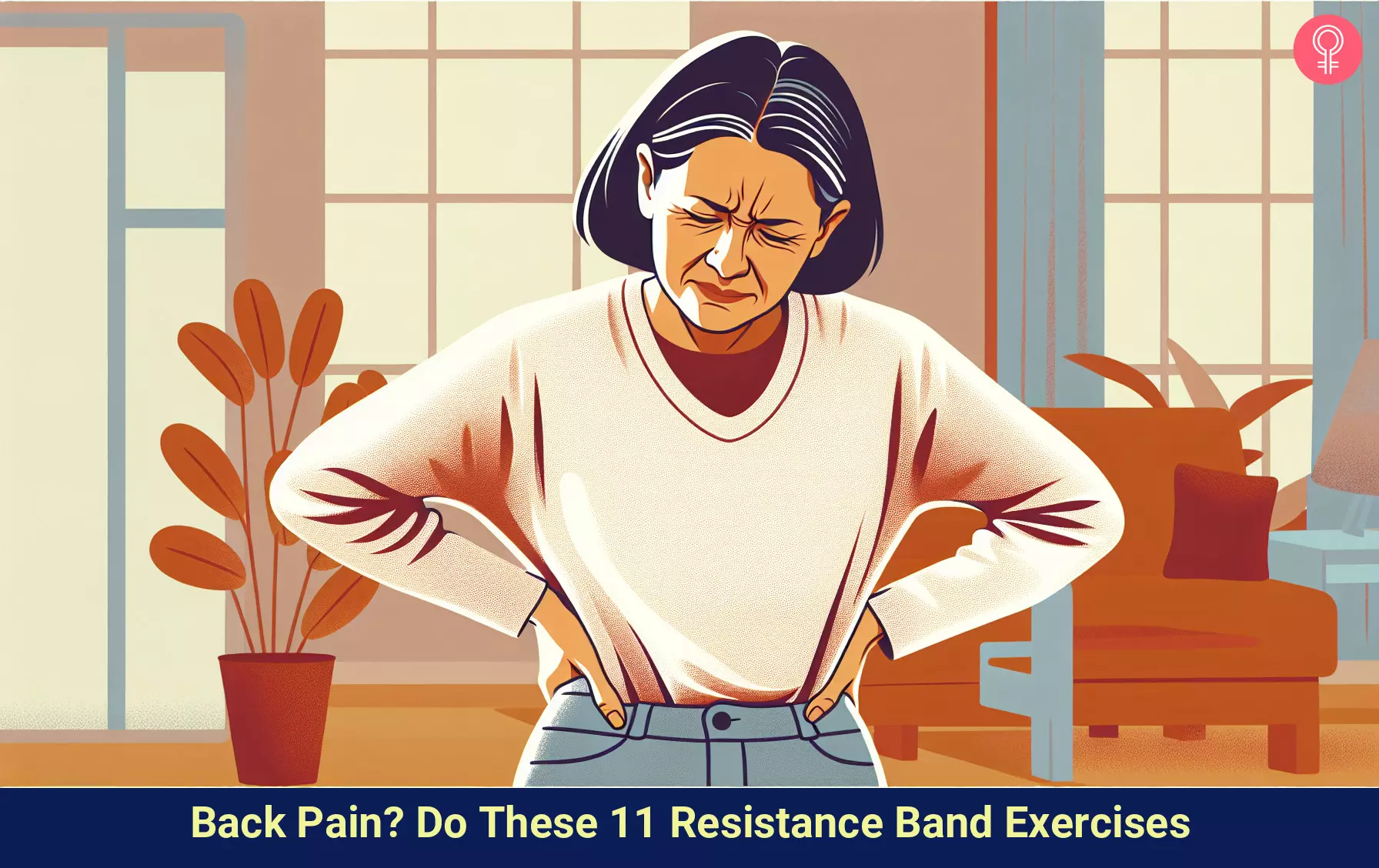
Image: Stable Diffusion/StyleCraze Design Team
Learn how to ease back pain using resistance bands! Look through the video to discover simple exercises to help reduce discomfort and improve mobility.
Personal Experience: Source
StyleCraze's articles are interwoven with authentic personal narratives that provide depth and resonance to our content. Below are the sources of the personal accounts referenced in this article.
i. RESISTANCE BAND WORKOUTShttps://buildingabetterlydia.com/2012/06/14/resistance-band-workouts/
Read full bio of Sabrina Rahman
Read full bio of Ravi Teja Tadimalla
Read full bio of Payal Karnik






